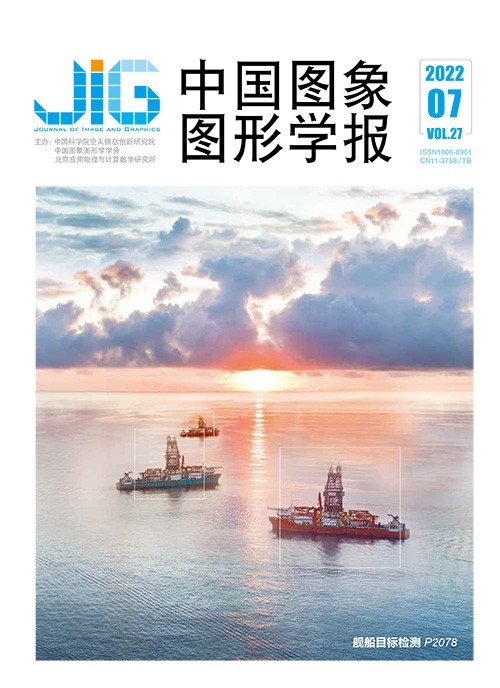
动态书法墨迹的可回溯感评测
律睿慜1, 梅莉琳2, 昃跃峰3, 晏涛1(1.江南大学人工智能与计算机学院, 无锡 214122;2.常州市钟楼外国语学校信息中心, 常州 213000;3.上海视觉艺术学院新媒体学院, 上海 201620) 摘 要
目的 可回溯感是艺术欣赏和临摹时产生的一种审美感受,即在审美过程中想象地再现原作的创作行为,是书法艺术凸显的审美心理现象。在计算机书法的研究中,鲜有研究以动画效果增强书法可回溯感,且缺少关于可回溯感的量化评估方法。因此,本文结合心理感知实验提出可回溯感的测评方法,并探究动态墨迹效果对书法作品可回溯感的影响。方法 首先将可回溯感分解为两种心理因素:顺序感和运动感。然后针对动态书法形式应用粒子动画制作7种不同墨迹效果,并设计心理感知实验对书法作品的可回溯感进行测量,即对选定标记点的运笔顺序进行排列以及对其运笔方向和相对速率进行估计。最后比较原作和动态书法可回溯感的差异,分析动态墨迹对书法作品可回溯感的影响。结果 实验结果证明测评方法是可行的,并发现恰当运用动态墨迹效果,即沿笔迹流动的墨迹动画,可以改进作品的运动感、显著增强顺序感以及提升可回溯感,反之则不能。若混入逆向流动墨迹效果,会削弱其提升顺序感的效用,但减弱的程度与正逆向墨迹的比例并非线性关系。结论 运笔顺序和笔触运动感知的评测方法可以有效量化视觉艺术品的可回溯感,为书法欣赏和临摹过程的研究提供实证方法。动态墨迹的设计也可用于增进书法的艺术化呈现,特别是增强其可回溯感。
关键词
Traceability evaluation of flowing calligraphy strokes
Lyu Ruimin1, Mei Lilin2, Ze Yuefeng3, Yan Tao1(1.School of Artificial Intelligence and Computer Science, Jiangnan University, Wuxi 214122, China;2.Department of Information, Changzhou Zhonglou Foreign Language School, Changzhou 213000, China;3.New Media College, Shanghai Institute of Visual Arts, Shanghai 201620, China) Abstract
Objective Quantitative evaluation of artworks is essential to experimental aesthetics, computational aesthetics, computer art and artificial intelligence (AI) art. Previous studies have proposed a variety of aesthetic qualities, such as objective indicators such as self-similarity and complexity, as well as subjective indicators such as aesthetic preference, emotion and style. Computational aesthetics focuses on the measurement and calculation of objective physical characteristics of artworks, while experimental aesthetics tends to measure subjective aesthetic feelings. However, for the art of calligraphy, previous studies have ignored a special aesthetic quality-traceability, that is, the viewer can reconstruct the movement process of brush movement by observing the static strokes on a piece of calligraphy artwork. In classical calligraphy theory, traceability is regarded as the characteristic of calligraphy art different from other categories. However, there is still a lack of empirical research on traceability. In view of this, this paper is just aimed at the empirical study of traceability. One potential application field of traceability evaluation is digital calligraphy, especially the aesthetic evaluation of dynamic calligraphy. At present, some studies have tried to reproduce the formation process of calligraphy handwriting with dynamic effect, but there is no appropriate quantitative evaluation means, especially it is impossible to confirm whether the dynamic work improves the traceability relative to the original piece. The proposed traceability evaluation method is facilitated to resolve the issue, which is a group of theoretic metrics with a perceptual experiment. In addition, the influence of the animated ink effect on the traceability of calligraphy work is studied. Method Theoretic metrics of traceability and a corresponding perceptual measurement experiment are proposed. The basic concept is that traceability can be decomposed into two psychological factors-sequential perception and velocity perception. Sequential perception refers to the ability to determine the sequential order of brushstrokes. Velocity perception refers to the ability to sense the writing direction and speed along strokes. Theoretic metrics are constructed to quantify the sequential perception and velocity perception. Correspondingly, a perceptual experiment is designed to do the actual measurement of the above two types of perception. The objectives of the experiment are 1) to testify the validity of the proposed metrics of traceability, and 2) to study the influence of animated ink effects on traceability. The experimental stimuli is generated by 3 steps as following:1) by performing the graphic transformation of mirroring and rotation, generates 8 distorted versions of the chosen calligraphic character "Qiu"; 2) by augmenting the 8 version with 7 animated ink effects, generates a total of 56 samples; 3) for each sample, add marking points at the ends and turns of the handwriting lines. Then, 1 641 participants were recruited for the experiments in the form of online test. Each participant is shown a randomly chosen piece of the 64 stimuli, and then do 2 subjective rating tasks on mark points:judging their sequential order, rating the writing direction and speed. By applying the proposed metrics to experimental data, the traceability of the original calligraphic character "Qiu" and its 7 animated versions is compared quantitatively. Result Our experimental results demonstrate that the evaluation method is feasible, and found that the appropriate use of animated ink effects, that is, the ink animation flowing along the handwriting traces, enhances the traceability of calligraphy artworks. The Statistics also show some detailed findings, as listed below:1) although the reversed flowing ink effect improves sequential perception, the perceived sequential order is opposite to the real writing direction; 2) artworks without flowing ink effect show low traceability under the interference of graphic transform; 3) the perceived sequential order may be the same as, or reverse to the original writing order, under graphic transforms; 4) although the sequentiality is high under each graphic transform, it is low when it is calculated based on the data of all graphic transforms; 5) if reversed flowing ink effect is mixed in, the effect of enhancing the sequential perception will be weakened, but the weakening degree shows nonlinear relationship with the proportion of forward and reversed flowing ink; 6) animated ink can improve the perception of writing direction, but it has little effect on the perception of writing speed. Conclusion Our proposed metrics and experiment can quantify the traceability of visual artworks. With appropriate animated ink effects, the traceability of calligraphy artworks is improved. The limitation of the experiment is that it can only approximate the proposed theoretical metrics roughly, and the experimental sample is limited to a single calligraphy character. In addition, the proposed method cannot measure writing movements such as "Ti, An, Dun, Cuo", which are typical ways of writing motions in classical calligraphy theory.
Keywords
traceability calligraphy empirical aesthetics aesthetic psychology psychological perception animation effects
|



 中国图象图形学报 │ 京ICP备05080539号-4 │ 本系统由
中国图象图形学报 │ 京ICP备05080539号-4 │ 本系统由